Social Sciences > EXAM > SHRM CP EXAM Study Guide Updated 2022/2023 (Passed Exam) (All)
SHRM CP EXAM Study Guide Updated 2022/2023 (Passed Exam)
Document Content and Description Below
Career Planning - ANSWER Actions & activities that individuals perform in order to give direction to their work lives. Brain drain - ANSWER Exit of educated & skilled citizens from emerging & devel... oping countries for better paying jobs in developed countries. Auditory learners - ANSWER People who learn best by relying on their sense of hearing. Andragogy - ANSWER Study of how adults learn. Cost-of-living adjustment (COLA) - ANSWER Pay adjustment given to eligible employees regardless of performance or organizational profitability; usually linked to inflation. Compa-ratio - ANSWER Pay rate divided by the midpoint of the pay range. Broadbanding - ANSWER Combining several salary grades or job classifications with narrow pay ranges unto one brand with a wider salary spread. Behavioral interview - ANSWER Type of interview that focuses on how applicants previously handled real situations. Applicant tracking software (ATS) - ANSWER Software that provides an automated way for organizations to manage the recruiting process. Developmental activities - ANSWER Activities that focus on preparing employees for future responsibilities while increasing their capacity to perform their current jobs. Compensation - ANSWER All financial returns (beyond any benefits payments or services), including salary and allowances. Career development - ANSWER Process by which employees progress through a series of stages in their careers, each of which is characterized by relatively unique, themes, and tasks. Benefits - ANSWER Payments or services provided to employees to cover issues such as retirement, health care, sick pay/disability schemes, life insurance, and paid time off. Apprenticeship - ANSWER Related to technical skills training; often a partnership between employers and unions. Competency-based interview - ANSWER Type of interview in which the interviewer asks questions related to competencies for the position and asks candidates to provide examples of times they demonstrated the competencies. ADDIE model - ANSWER 5 step instructional design process that governs the development of learning programs. Assessment centers - ANSWER Assessment tools that provide candidates a wide range of leadership situations and problem-solving exercises. Blended learning - ANSWER Planned approach to learning that included a combination of instructor-led training, self-directed study, and /or on-the-job training. Career management - ANSWER Preparing, implementing, and monitoring employees' career paths, with a primary focus on the goals and needs of the organization. Competencies - ANSWER Clusters of highly interrelated attributes, including knowledge, skills, or abilities (KSA) that give rise to the behaviors needed to perform a given job effectively. Strategy - ANSWER A plan of action for accomplishing an organization's long-range goals. SWOT analysis - ANSWER Process for assessing an organization's strategic capabilities in comparison to threats and opportunities identified during environmental scanning. Value drivers - ANSWER Actions, processes, or results that are needed to deliver a desired value. Vision statement - ANSWER Vivid, guiding image of an organization's desired future, the future it hopes to attain through its strategy. Organizational values - ANSWER Beliefs that are important to an organization and often dictate employee behavior. Strategic fit - ANSWER A state in which an organization's strategy is consistent with its external opportunities and circumstances and its internal structure, resources, and capabilities. Strategic management - ANSWER The actions that leaders take to move their organizations toward those goals and create value for all stakeholders. Strategic planning - ANSWER The process of setting goals and designing a path toward a competitive position. Metrics - ANSWER Performance parameters based on the relationship between 2 or more measures. Mission statement - ANSWER Statement that specifies what activities an organization intends to pursue and what course management has carted for the future; a concise statement of its strategy. Net profit margin - ANSWER Ratio of net income (gross sales minus expenses and taxes) to net sales. Organizational culture - ANSWER The basic beliefs and customs shared by members of an organization that contribute to an organization's sense of its identity. Income statement - ANSWER Statement that reports revenues, expenses, and net income (profit) for a specified period. Lagging indicator - ANSWER Type of metric that describes an activity that has already occurred. Leading indicator - ANSWER Type of metric that describes an activity that can change future performance and indicate higher degree of success in achieving strategic goals. Liabilities - ANSWER Organization's debts and other financial obligations. Due diligence - ANSWER Necessary level of care and attention that is taken to investigate an action before it is taken. Environmental scanning - ANSWER Process that involves a systematic survey and interpretation of relevant data to identify external opportunities and threats and to assess how these factors affect the organization currently and how they are likely to affect the organization in the future. Equity - ANSWER Amount of owners' or shareholders' portion of a business. Gross profit margin - ANSWER Ratio of gross profit to net sales. Benchmarking - ANSWER Process that compares performance levels and/or processes of one entity with those of another to identify performance gaps and set goals aimed at improving performance. Blue ocean strategies - ANSWER Strategies that generate competitive advantage by creating a new marketplace arena in which there are no other competitors. Business case - ANSWER Presentation to management that establishes that a specific problem exists and argues that the proposed solution is the best way to solve the problem in terms of time, cost efficiency, and probability of success. Cash flow statement - ANSWER Statement the shows incoming and outgoing cash in the areas of operations, investments, and financing and remaining cash reserves; reflects an organization's ability to meet its current and short-term obligations. Accounts payable - ANSWER Money an organization owed its vendors and suppliers. Accounts receivable - ANSWER Money an organization's customers owe the organization. Assets - ANSWER Financial, physical, and sometimes intangible properties an organization owns. Balance sheet - ANSWER Statement that reports the financial position of the organization at a specific point in time; shows assets, liabilities, and shareholder equity. Vicarious liability - ANSWER Legal doctrine under which a party can be held liable for the wrongful actions of another party. Weingarten rights - ANSWER Union employees' right in U.S. to have a union representative or coworker present during an investigatory interview. Worker Adjustment and Retraining Notification (WARN) Act - ANSWER U.S. act that requires some employers to give a minimum of 60 days' notice if a plant is to close or is mass layoffs will occur. Workweek - ANSWER Any fixed, recurring period of 168 consecutive hours (7 days time 24 hours = 168 hrs) Uniform Guidelines on Employee Selection Procedures - ANSWER Procedural document designed to assist employers in complying with federal regulations prohibiting discrimination. Uniformed Services Employment and Reemployment Rights Act (USERRA) - ANSWER U.S. act that protects the employment reemployment, and retention rights of persons who serve or have served in the uniformed services. Vesting - ANSWER Process by which a retirement benefit becomes nonforfeitable. Veto - ANSWER Action of rejecting a bill or statute. Stakeholders - ANSWER All those affected by an organization's social, environmental, and economic impact shareholders, employees, customers, suppliers, regulators, and local communities. Sustainability - ANSWER Practices that balance economic, social, and environmental interests to secure the interests of present and future generations. Totaization agreements - ANSWER Bilateral agreements entered into by many countries to eliminate double taxation for individuals on international assignments. Triple bottom line - ANSWER Economic, social, and environmental impact metrics used to determine an organization's success. Risk management - ANSWER Identification, evaluation, and control of risk that may affect an organization, typically incorporating the use of insurance and other strategies. Risk position - ANSWER An organization's desired gain or acceptable loss in value. Risk scorecard - ANSWER Tool used to gather individual assessments of various characteristics of risk (e.g. frequency of occurrence, degree of impact/loss/gain for the organization, degree of efficacy of current controls). Risk tolerance - ANSWER Amount of uncertainty an organization is willing to pursue or to accept to attain its risk management. Reverse innovation - ANSWER Innovations created for or by emerging-economy markets and then imported to developed-economy markets. Risk - ANSWER The effect of uncertainty or objectives; outcomes may include opportunities or threats. Risk appetite - ANSWER Amount of risk the organization or function is willing to pursue or accept to attain its goals. Risk control - ANSWER An action taken to manage a risk. Redeployment - ANSWER Process by which an organization moves an employee out of an international assignment; can involve moving back to the home country, moving to a different global location, or moving to a new location or position in the current host country. Regulation - ANSWER A rule or order issues by an administrative agency; often has the force of law. Repatriation - ANSWER Process of reintegrating employees back into the home country after an assignment; includes adjustment to the new job and readjustment to the home culture and conditions. Residual risk - ANSWER Amount of uncertainty that remains after all risk management efforts have been exhausted. Protected class - ANSWER People who are covered under a particular federal or state anti-discrimination law. Prudent person rule - ANSWER States that an Employee Retirement Income Security Act plan fiduciary has legal and financial obligations not to take more risks when investing employee benefit program funds than a reasonable knowledgeable, prudent investor would under similar circumstances. Public comment period - ANSWER Time allowed for the public to express its views and concerns regarding an action of an administrative agency. Quid pro quo harassment - ANSWER Type of sexual harassment that occurs when an employee is forces to choose between giving in to a superior's sexual demands and forfeiting an economic benefit such as a pay increase, a promotion, or continues employment. Portal-to-Portal Act - ANSWER U.S. act that defines what is included as hours worked and is therefore compensable and a factor in calculating overtime. Pregnancy Discrimination Act - ANSWER U.S. act that prohibits discrimination on the basis of pregnancy, childbirth, or related medical conditions. Principal-agent problem - ANSWER Situation in which and agent (e.g. an employee) make decisions for a principal (e.g. an employer) potentially on the basis of personal incentives that may not be aligned with the agent's incentives. Process alignment - ANSWER Extent to which underlying operations such as IT, finance, or HR integrate across locations. Overtime pay - ANSWER Required for nonexempt workers under U.S. Fair Labor Standards Act at 1.5 time the regular rate of pay for hours worked over 40 in a workweek. Patient Protections and Affordable Care Act (PPACA) - ANSWER 2010 U.S. law the requires virtually all citizens and legal residents to have minimum health coverage and requires employers with more than 50 full-time employees to provide health coverage that meets minimum benefit specifications or pay a penalty. Pension Benefit Guaranty Corporation (PBGC) - ANSWER Set up by U.S. Employee Retirement Income Security Act to insure payment of benefits in the even that a private-sector defined benefit pension plan terminates with insufficient funds to pay the benefits. Phillips v. Martin Marietta Corporation - ANSWER 1971 U.S. case that stated than an employer may not, in the absence of business necessity, refuse to hire women with preschool aged children while hiring men with such children. Occupational Safety and Health Act (OSH) - ANSWER U.S. act that established the first national policy for safety and health and continues to deliver standards that employers must meet to guarantee the health and safety of their employees. Occupational Safety and Health Administration (OSHA) - ANSWER U.S. agency that administers and enforces the Occupational Safety and Health Act of 1970. Offshoring - ANSWER Situation in which a company relocated processes or production to an international location by means of subsidiaries or 3rd party affiliates. Older Workers Benefit Protection Act (OWBPA) - ANSWER U.S. act that amended the Age Discrimination in Employment Act to included all employee benefits; also provided standards that an employee's waiver of the right to sue for age discrimination must meet in order to be upheld by a court. NLRB v. Weingarten - ANSWER Landmark 1975 U.S. labor relations case the dealt with the right of a unionized employee to have another person present during certain investigatory interviews. Nonexempt employees - ANSWER Employees covers under U.S. Fair Labor Standards Act regulations, including minimum wage and overtime pay requirements. Occupational illness - ANSWER Medical condition or disorder, other than one resulting from an occupational injury, caused by exposure to environmental factors associated with employment. Occupational injury - ANSWER Injury that results from a work-related accident or exposure involving a single incident int he work environment. National Defense Authorization Acts (NDAA) - ANSWER U.S. acts that expanded FMLA leave for employees with family members who are covered members of the military. National Federation of Independent Business v Sebelius - ANSWER U.S. Supreme Court ruling that Patient Protections and Affordable Care Act requirement that individuals purchase health insurance was constitutional but that requirement that states expand Medicaid was not. National Labor Relations Act (NLRA) - ANSWER U.S. act that protects and encourages the growth of the union movement. The act established workers rights to organize and bargain collectively with the employers; also known as the Wagner Act. National origin - ANSWER Refers to the country (including those that no longer exist) of one's birth or of one's ancestors' birth. Low-context culture - ANSWER Society in which people tend to have many social connections but of shorter duration and where behavior and beliefs may need to be described explicitly so that those coming into the cultural environment know how to behave. Merger/acquisition (M&A) - ANSWER Combination of 2 separate firms either by their joining together as relative equals (merger) or by one acquiring the other (acquisition). Moral hazard - ANSWER Situation in which one party engages in risky behavior knowing that is is protected against the risk because another party will incur any resulting loss. Multinational enterprise (MNE) - ANSWER Organization that owns or controls production or services facilities in one or more countries other than the home country. Lechmere, Inc. v NLRB - ANSWER 1992 case in which the U.S. Supreme Court rules that an employer cannot be compelled to allow non-employee organizers onto the business property. Ledbetter v Goodyear Tire & Rubber Co, - ANSWER 2007 case in which the U.S. Supreme Court rules that claims of sex discrimination in pay under Title VII were not timely because discrimination charges were not filed with the EEOC within the required 180-day time frame. Lilly Ledbetter Fair Pay Act - ANSWER U.S. act the creates a rolling time frame for filing wage discrimination claims and expands plaintiff field beyond employee who was discriminated against. Local responsiveness (LR) strategy - ANSWER Globalization strategy that emphasizes adapting to the needs of local markets and allows subsidiaries to develop unique products, structures, and systems. Insourcing - ANSWER Transferring a previously outsourced function back in-house. Key risk indicators (KRIs) - ANSWER Metrics that provide an early signal of increasing risk exposures in the various areas of an enterprise. Labor-Management Relations Act (LMRA) - ANSWER U.S. act that provides balance of power between union and management by designating certain union activities as unfair labor practices; also knows as Taft-Hartley Act. Labor-Management Reporting and Disclosure Act (LMRDA) - ANSWER U.S. act that protects the rights of union members from corrupt or discriminatory labor unions; also known as Landrum-Griffin Act. Hostile environment harassment - ANSWER Occurs when sexual or other discriminatory conduct is so severe and pervasive that it interferes with an individual's performance; creates an intimidating, threatening, or humiliating work environment; or perpetuates a situation that affects the employee's psychological well-being. Identity alignment - ANSWER Extent to which diversity is is embraced in management of people, products/services, and branding. Immigration Reform and Control Act (IRCA) - ANSWER U.S. act that prohibits discrimination against jobs applicant on the basis of national origin or citizenship; establishes penalties for hiring illegal aliens and requires employers to establish each employee's identity and eligibility to work. Inclusion - ANSWER Extent to which each person in an organization feels welcomed, respected, supported, and valued as a team member. Governance - ANSWER System of rules and processes an organization puts in place to ensure its compliance with local and international laws, accounting rules, ethical norms, and its own codes of conduct. Griggs v Duke Power - ANSWER U.S. case that recognized adverse impact discrimination. Hazard - ANSWER Potential for harm, often associated with a condition or activity that, if left uncontrolled, can result in injury or illness. High-context culture - ANSWER Society or group where people have close connections over a long period of time and where many aspects of behavior are not made explicit, because most members know what to do and thing from years of interaction. Global integration (GI) strategy - ANSWER Globalization strategy that emphasizes consistency of approach, standardization of processes, and a common corporate culture across global operations. Global remittances - ANSWER Monies sent back home by migrants working in foreign countries. Globalization - ANSWER Growing interconnectedness and interdependency of countries, people, and companies. Glocalization - ANSWER Characteristic of an organization with a strong global image but an equally strong local identity. Gender - ANSWER Refers to the society constructed system that associates masculinity or femininity to certain roles, behaviors, activities, and attributes. Gender identity - ANSWER Refers to one's internal, personal sense of being a man or a woman (or boy or girl), which may or may not be the same as one's sexual assignment at birth. General Duty Clause - ANSWER Statement in U.S. Occupational Safety and Health Act that requires employers subject to OSHA to provide employees with a safe and healthy work envrionment. Genetic Information Nondiscrimination Act (GINA) - ANSWER U.S. act that prohibits discrimination against individuals on the basis of their genetic information in both employment and health insurance. Fair Credit Reporting Act (FCRA) - ANSWER U.S. act that protects privacy of background information and ensures that information supplies is accuate. Fair Labor Standards Act (FLSA) - ANSWER U.S. act that establishes minimum wage, overtime pay, youth employment, and record-keeping standards affecting full-time and part-time workers in the private sector and in federal, state, and local governments. Family and Medical Leave Act (FMLA) - ANSWER U.S. act that provides employees with up to 12 weeks of unpaid leave to care for family members or because of a serious health condition of the employee. Faragher v. City of Boca Raton - ANSWER U.S. court ruling that distinguished between supervisor harassment that results in tangible employment action and supervisor harassment that does not. Equal Pay Act (EPA) - ANSWER U.S. act that prohibits wage discrimination by requiring equal pay for equal or "substantially equal" work. Ethics - ANSWER Set of behavioral guidelines by which all directors, managers, and employees of an organization are expected to behave to ensure appropriate moral and ethical business standards, typically beyond the letter of the law. Exempt employees - ANSWER Employees who are excluded from U.S. Fair Labor Standards Act minimum wage and overtime pay requirements. Fair and Accurate Credit Transactions Act (FACT Act) - ANSWER U.S. act that provides some relief to employers using third parties to conduct workplace investigations. Employee Retirement Income Security Act (ERISA) - ANSWER U.S. act that established uniform minimum standards for employer-sponsored retirement and health and welfare benefit programs. Employees - ANSWER Individuals who exchange work for wages or salary; in the U.S. workers who are covered by Fair Labor Standards Act regulations as determined by the IRS. Employment practices liability insurance (EPLI) - ANSWER Type of liability insurance covering an organization against claims by employees, former employees, and employment candidates alleging that their legal rights in the employment relationship have been violated. Equal Employment Opportunity Act - ANSWER U.S. act that amended Title VII and gave the Equal Opportunity Commission authority to implement its administrative findings and conduct its own enforcement litigation. Drug-Free Workplace Act - ANSWER U.S. law that requires federal contractors with contracts of $100,000 or more as well as recipients of grants from federal government to certify they are maintaining a drug-free workplace. Duty of care - ANSWER Principle that organizations should take all steps that are reasonably possible to ensure the health, safety, and well-being of employees and protect them from foreseeable injury. Employee Polygraph Protection Act (EPPA) - ANSWER U.S. act that generally prevents most private employers engaged in or affecting interstate commerce from using lie detector tests either for pre-employment screening or during the course of employment, with certain exemptions. Employee resource group (ERG) - ANSWER Voluntary group for employees who share a particular diversity dimension (race, religion, ethnicity, sexual orientation, etc); also known as affinity group or network group. Diversity council - ANSWER Task force created to define a diversity and inclusion initiative and guide the development and implementation process. Diversity dimensions - ANSWER Framework for understanding the range and complexity of diversity; includes four layers (personality, internal dimensions, external dimensions, and organizational dimensions); also known as identity group. Diversity of thought - ANSWER Concept describing the presence of different types of cognitive processes in a workplace; opposed to "groupthink" or similarity of though processes and opnions. Divestiture - ANSWER Sale by company of an asset that is not performing well, that is not core to the company's business, or that is worth more as a separate entity. Disability - ANSWER Physical or mental impairment that substantially limits major life activities. Disparate impact - ANSWER Type of discrimination that results when a neutral policy has a discriminatory effect; also known as adverse impact. Disparate treatment - ANSWER Type of discrimination that occurs when an applicant or employee is treated differently because of his or her membership in a protected class. Diversity - ANSWER Differences in characteristics of people; can involve personality, work style, race, age, ethnicity, gender, religion, education, functional level at work, etc. Contingency plan - ANSWER Protocol than an organization implements when an identified risk event. Corporate social responsibility (CSR) - ANSWER Recognition of the impact a corporations has on the lives of its stakeholders and the environment; can include corporate governance, corporate philanthropy, sustainability, and employee rights and workplace safety. Cosourcing - ANSWER Situation in which an enterprise outsources only one part of a function, often collocating it at the organization's workplace. Dilemma reconciliation - ANSWER Process of charting a course through cultural differences. Comparable worth - ANSWER Concept that states that jobs requiring comparable skills, effort, responsibility, and working conditions filled primarily by women should have the same job classification and salary as similar jobs filled by men. Compliance - ANSWER Being in accordance with all national federal, regional, or local laws, regulations, and government authority requirements for all the nations in which an organization operates. Compliance program - ANSWER System for ensuring that policies and procedures addressing issues identified in the code of conduct are presented to and understood and acted on by everyone in the organization and for evaluating the results of those efforts. Consolidated Omnibus Budget Reconciliation Act (COBRA) - ANSWER U.S. act that provides individuals and dependents who may lose medical coverage with opportunity to pay to continue coverage. [Show More]
Last updated: 1 year ago
Preview 1 out of 32 pages
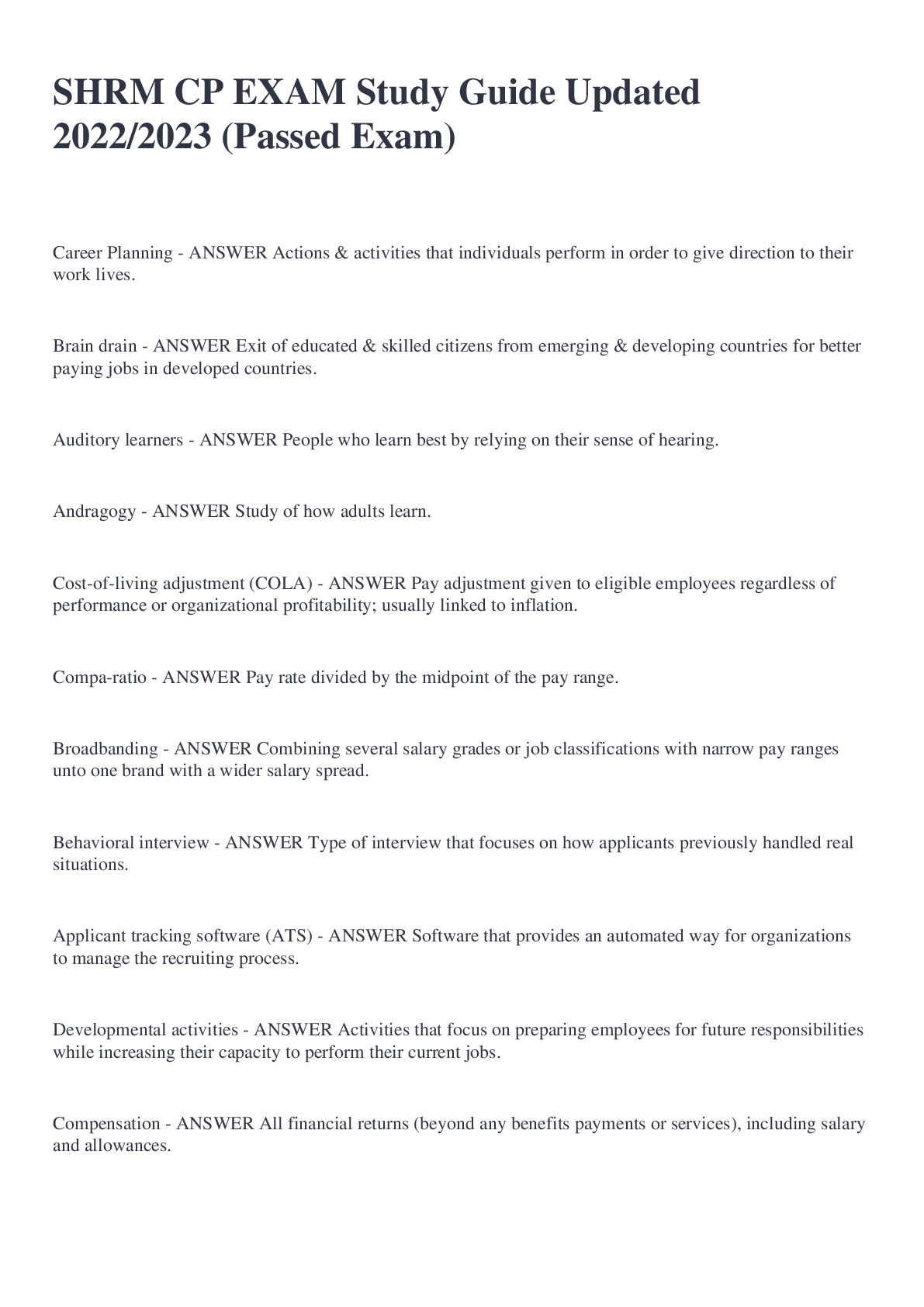
Reviews( 0 )
Recommended For You
*NURSING> EXAM > NUR 2790 / NUR2790 Professional Nursing III / PN3 Final Exam Study Guide Questions and Answers . Rasmussen College (All)
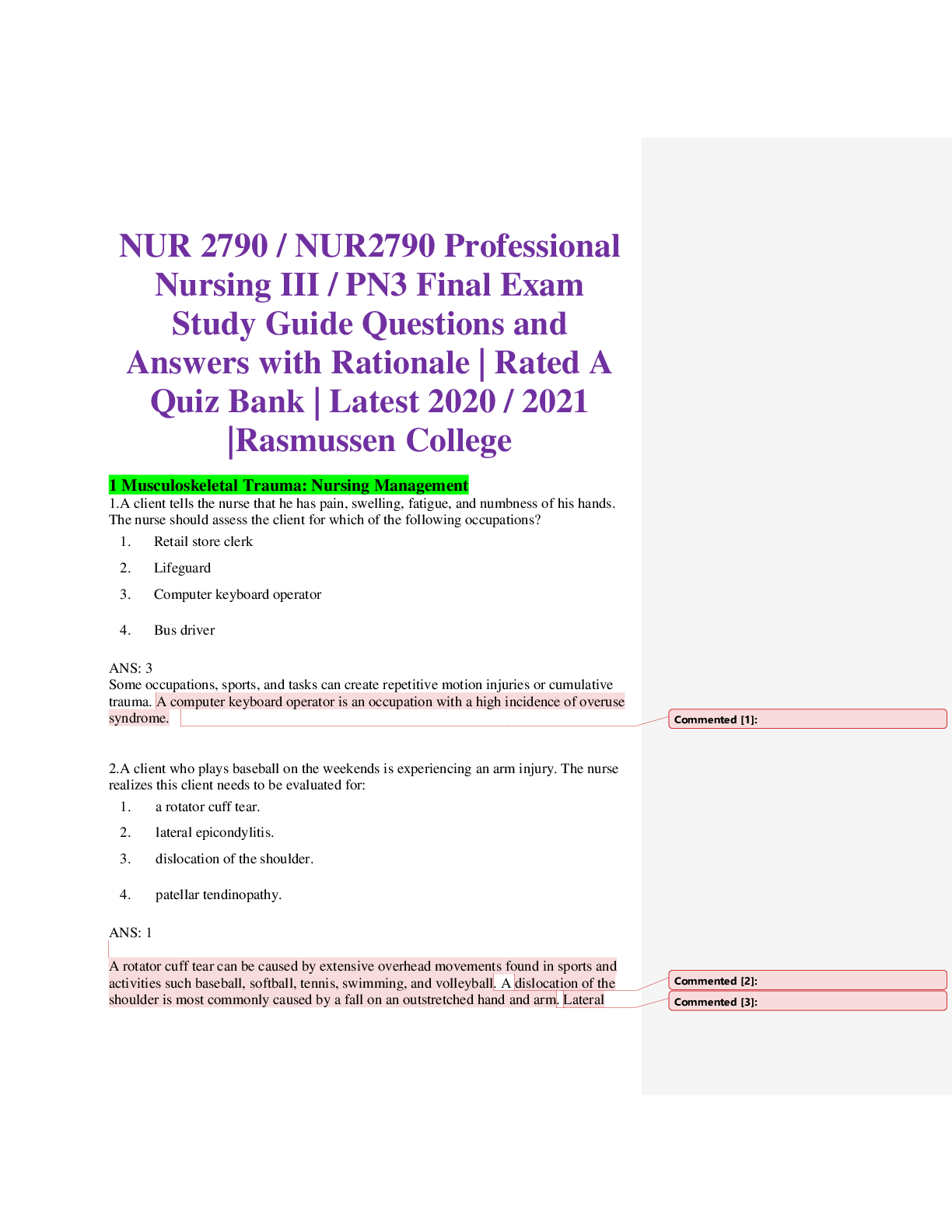
NUR 2790 / NUR2790 Professional Nursing III / PN3 Final Exam Study Guide Questions and Answers . Rasmussen College
NUR 2790 / NUR2790 Professional Nursing III / PN3 Final Exam Study Guide Questions and Answers with Rationale | Rated A Quiz Bank | Latest 2020 / 2021 |Rasmussen College 1 Musculoskeletal Trauma: N...
By nurse_steph , Uploaded: Dec 10, 2020
$12
Health Care> EXAM > NR 599 Week 8 Final Exam study Guide/ NR 599 Week 8 Final Exam study Guide (All)
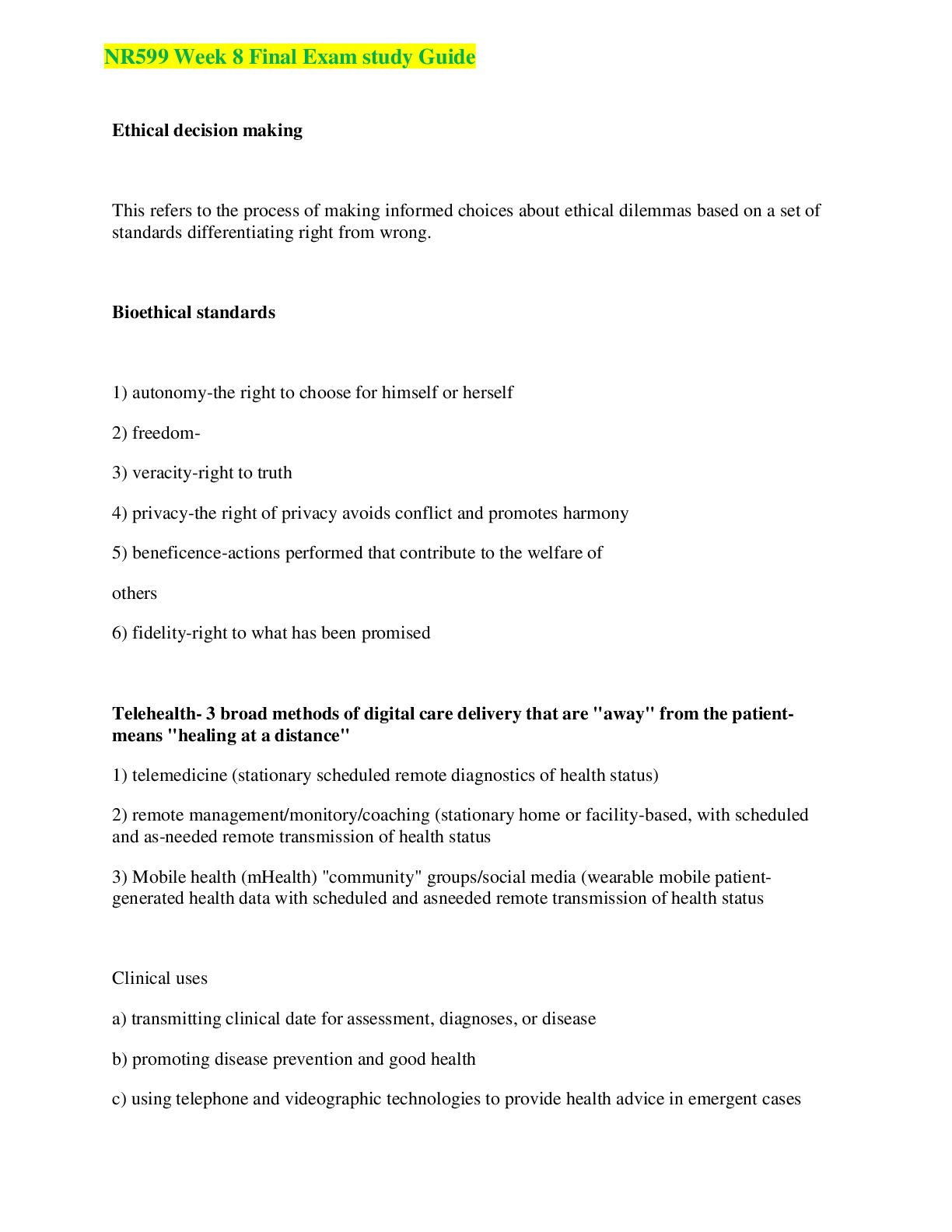
NR 599 Week 8 Final Exam study Guide/ NR 599 Week 8 Final Exam study Guide
NR599 Week 8 Final Exam study Guide
By QUIZBANK , Uploaded: Feb 21, 2021
$8
*NURSING> EXAM > NR566 Advanced Pharmacology for Care of the Family. Final Exam study guide (All)
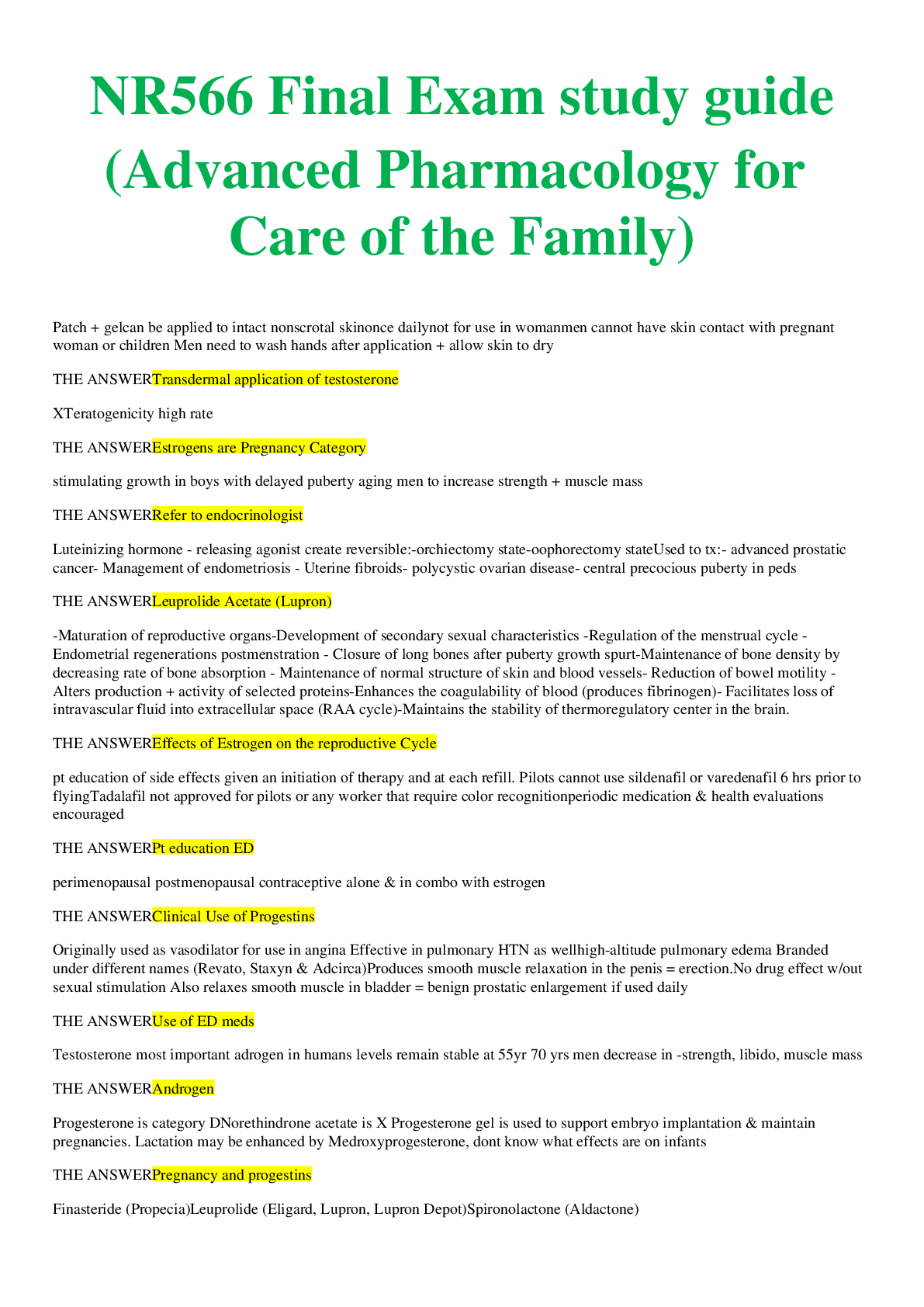
NR566 Advanced Pharmacology for Care of the Family. Final Exam study guide
NR566 Final Exam study guide (Advanced Pharmacology for Care of the Family) 1. Patch + gel can be applied to intact nonscrotal skin once daily not for use in woman men cannot have skin contact...
By A GRADE , Uploaded: Dec 18, 2020
$12
*NURSING> EXAM > NR565 / NR 565 Advanced Pharmacology Fundamentals Final Exam Study Guide | Rated A (All)
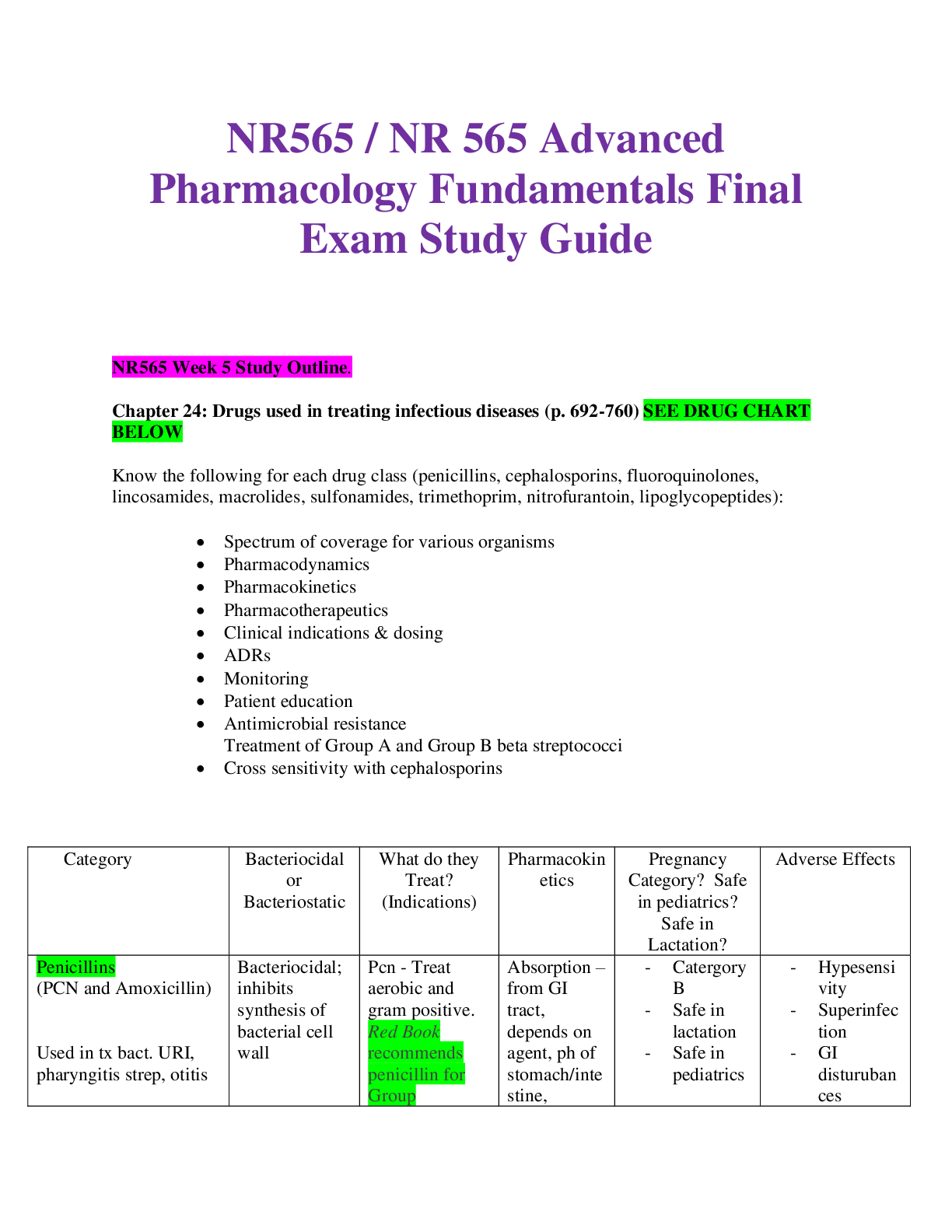
NR565 / NR 565 Advanced Pharmacology Fundamentals Final Exam Study Guide | Rated A
NR565 / NR 565 Advanced Pharmacology Fundamentals Final Exam Study Guide | Rated A | Latest 2020 / 2021 NR565 Week 5 Study Outline. Chapter 24: Drugs used in treating infectious diseases (p. 692-760)...
By nurse_steph , Uploaded: Dec 10, 2020
$13
*NURSING> EXAM > NUR 2063 / NUR2063 Essentials of Pathophysiology Final Exam Study Guide| Modules 1-10 | Highly Rated | Latest, 2020 / 2021 | Rasmussen College (All)
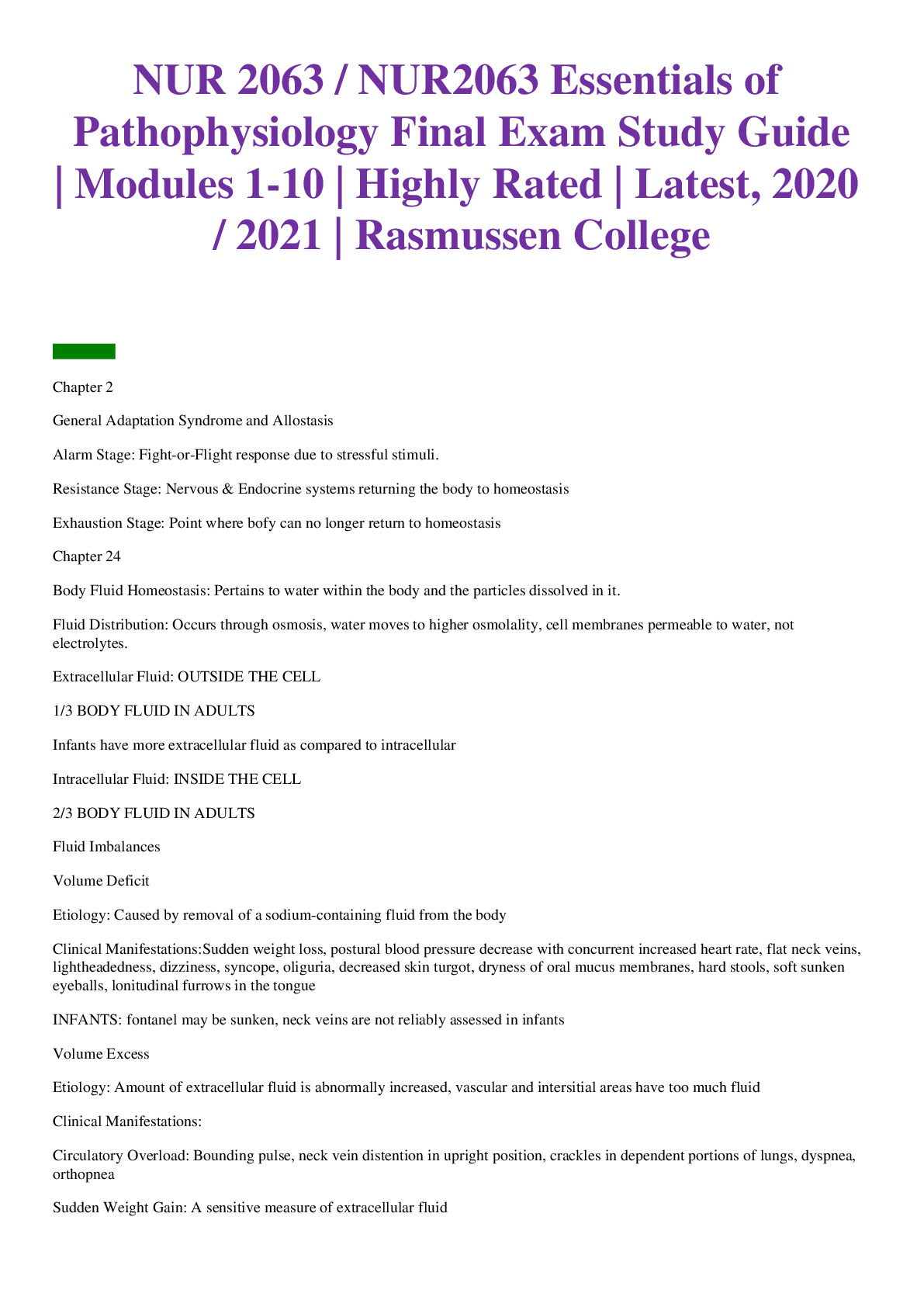
NUR 2063 / NUR2063 Essentials of Pathophysiology Final Exam Study Guide| Modules 1-10 | Highly Rated | Latest, 2020 / 2021 | Rasmussen College
NUR 2063 / NUR2063 Essentials of Pathophysiology Final Exam Study Guide| Modules 1-10 | Highly Rated | Latest, 2020 / 2021 | Rasmussen College Module 1 Chapter 2 I. General Adaptation Syndrome...
By nurse_steph , Uploaded: Dec 11, 2020
$13
*NURSING> EXAM > NR 509 / NR509 Advanced Physical Assessment Final Exam Study Guide | Highly Rated Complete Guide| Latest | Chamberlain College (All)
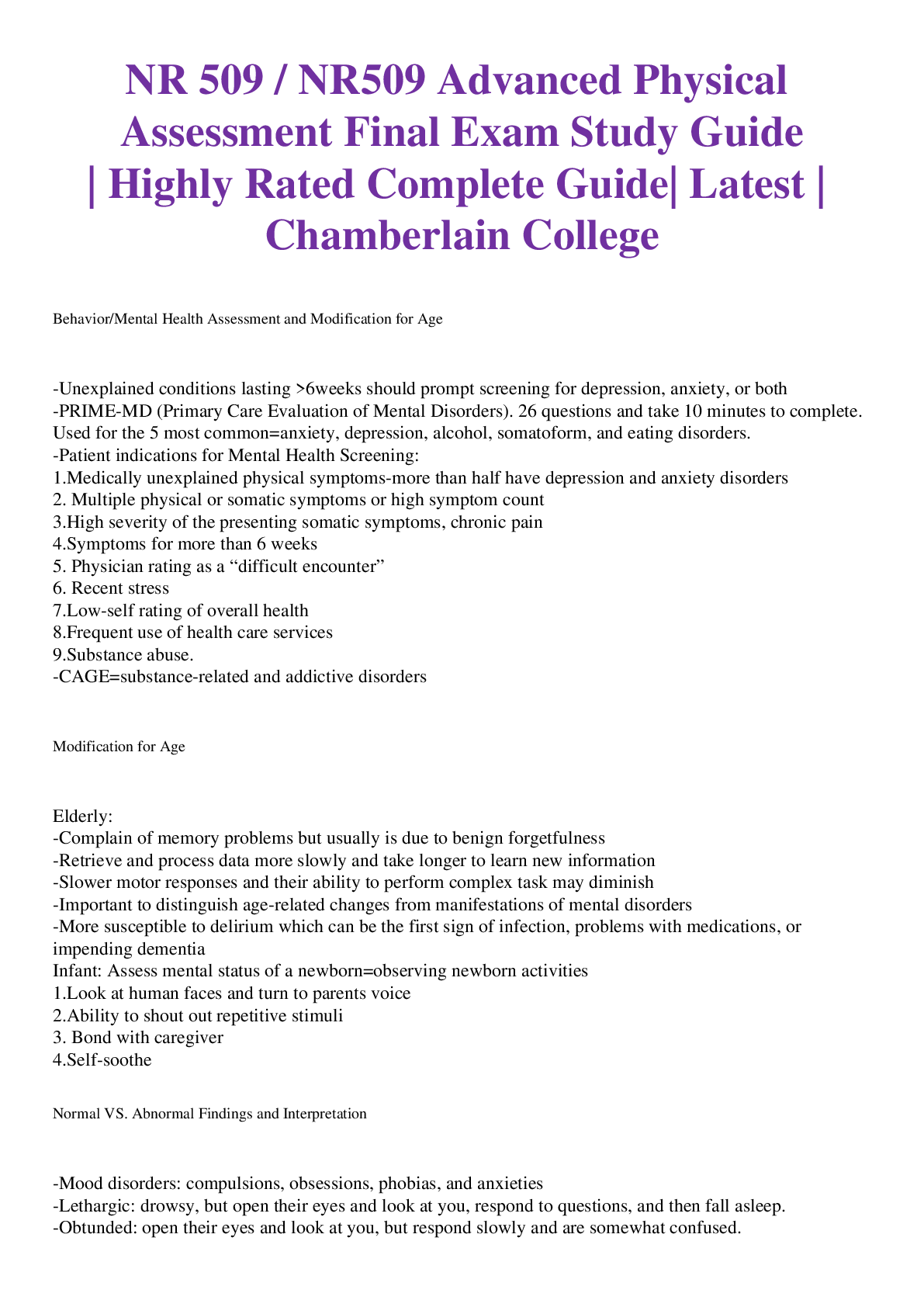
NR 509 / NR509 Advanced Physical Assessment Final Exam Study Guide | Highly Rated Complete Guide| Latest | Chamberlain College
NR 509 / NR509 Advanced Physical Assessment Final Exam Study Guide | Highly Rated Complete Guide| Latest | Chamberlain College Behavior/Mental Health Assessment and Modification for Age -Unexp...
By nurse_steph , Uploaded: Dec 17, 2020
$15
*NURSING> EXAM > NR 599 / NR599 Nursing Informatics for Advanced Practice Final Exam Study Guide | Week 5 -8 | Latest 2020 / 2021 | Chamberlain College (All)

NR 599 / NR599 Nursing Informatics for Advanced Practice Final Exam Study Guide | Week 5 -8 | Latest 2020 / 2021 | Chamberlain College
NR 599 / NR599 Nursing Informatics for Advanced Practice Final Exam Study Guide | Week 5 -8 | Latest 2020 / 2021 | Chamberlain College Ethical decision making ○ When making choices about ethic...
By nurse_steph , Uploaded: Dec 19, 2020
$13
*NURSING> EXAM > NUR2474 / NUR 2474 Pharmacology for Professional Nursing Final Exam Study Guide | Rated A | Latest 2020 / 2021 | Rasmussen College (All)
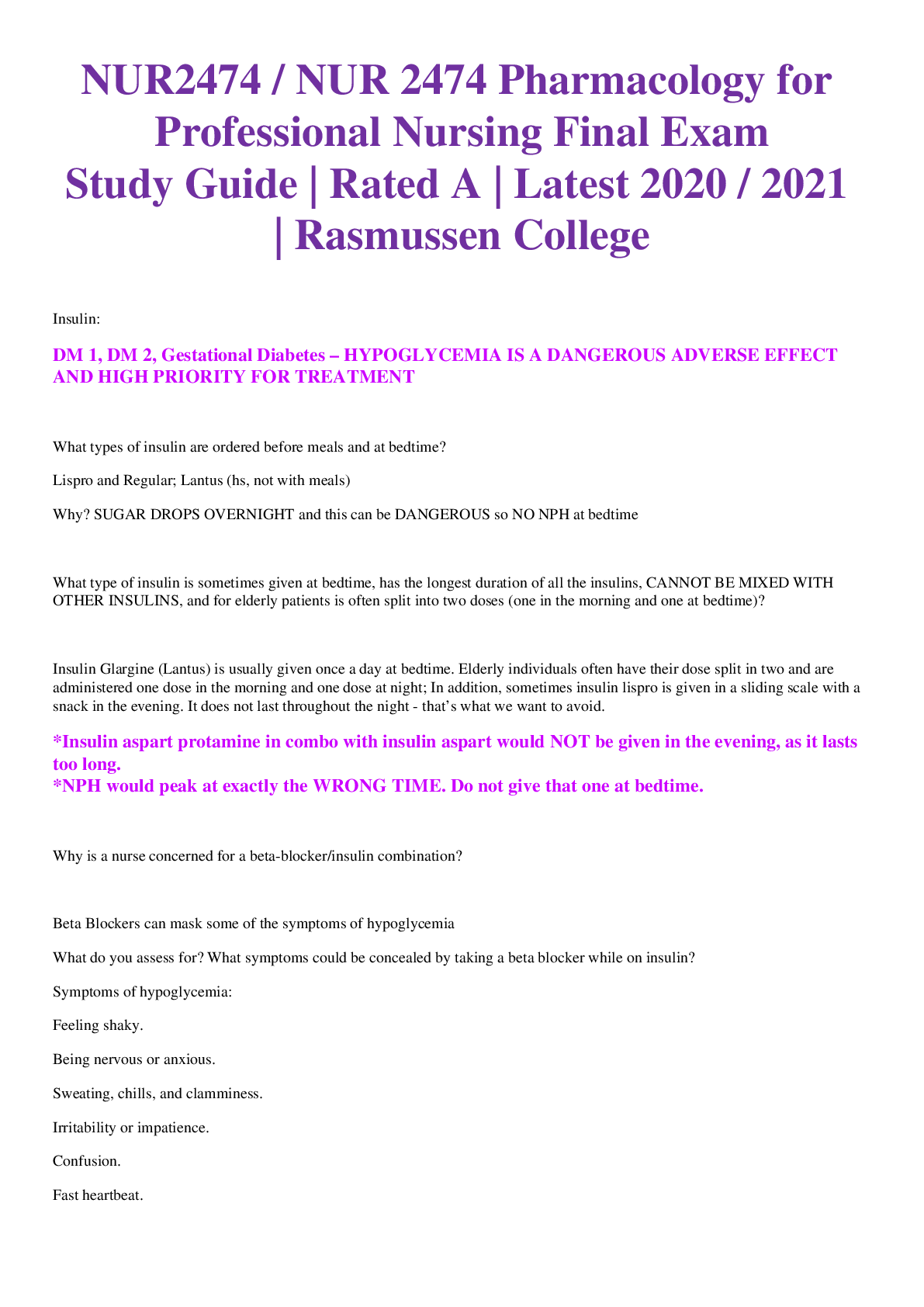
NUR2474 / NUR 2474 Pharmacology for Professional Nursing Final Exam Study Guide | Rated A | Latest 2020 / 2021 | Rasmussen College
NUR2474 / NUR 2474 Pharmacology for Professional Nursing Final Exam Study Guide | Rated A | Latest 2020 / 2021 | Rasmussen College 1. Insulin: DM 1, DM 2, Gestational Diabetes – HYPOGLYCEMIA IS A...
By nurse_steph , Uploaded: Dec 22, 2020
$11
*NURSING> EXAM > PN VATI Comprehensive Predictor 2020 Exam Study Guide Questions and answers (All)

PN VATI Comprehensive Predictor 2020 Exam Study Guide Questions and answers
PN VATI Comprehensive Predictor 2020 Exam Study Guide Questions and answers Which of these instructions should a nurse include in the teaching plan for a client who had removal of a cataract in th...
By tutorcwakuthii , Uploaded: Nov 25, 2023
$11
*NURSING> EXAM > CALT Exam Study Guide 400+ Question and 100% Verified Answers. (All)
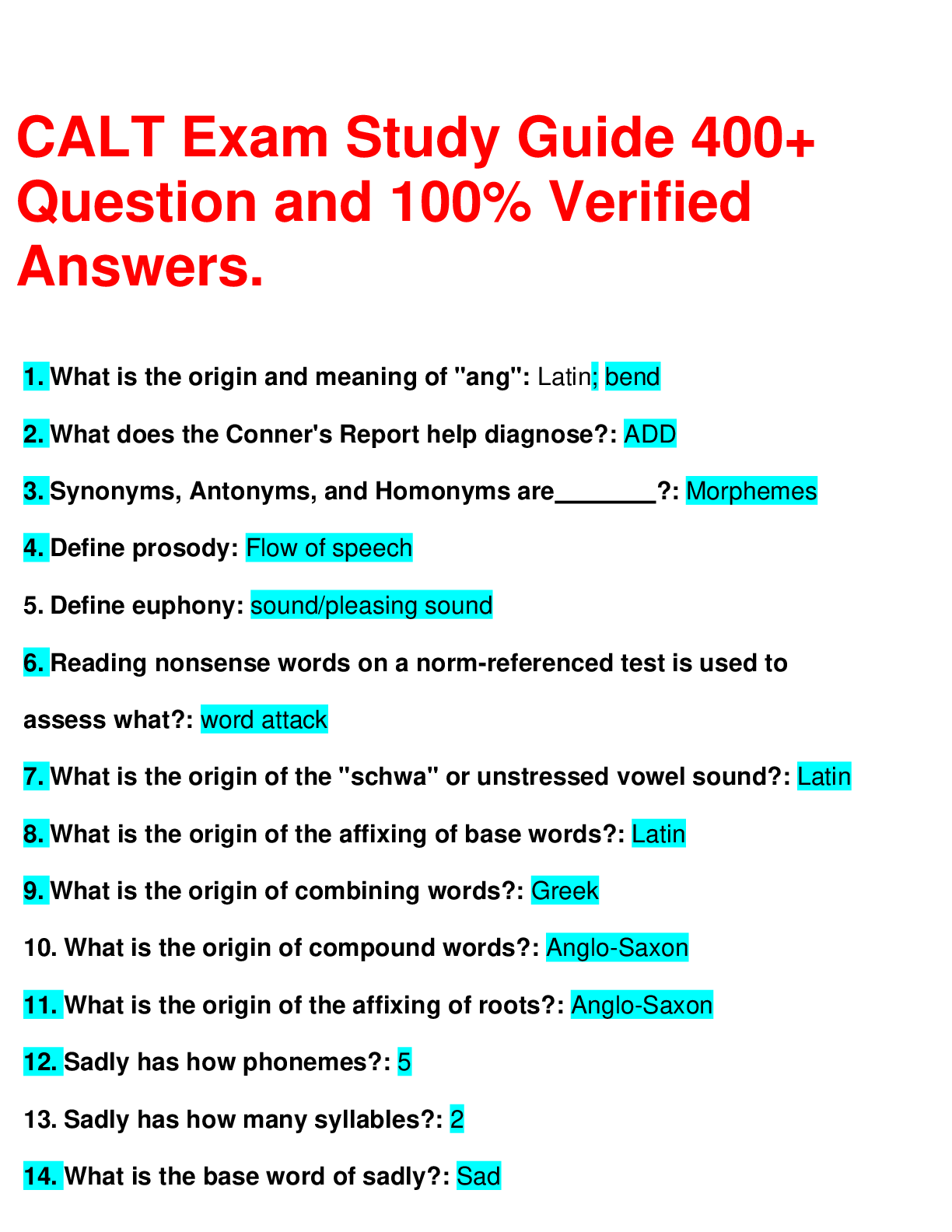
CALT Exam Study Guide 400+ Question and 100% Verified Answers.
CALT Exam Study Guide 400+ Question and 100% Verified AnswersCALT Exam Study Guide 400+ Question and 100% Verified Answers..
By proffecer , Uploaded: Oct 12, 2023
$8.5
Document information
Connected school, study & course
About the document
Uploaded On
Nov 21, 2022
Number of pages
32
Written in
Additional information
This document has been written for:
Uploaded
Nov 21, 2022
Downloads
0
Views
142






